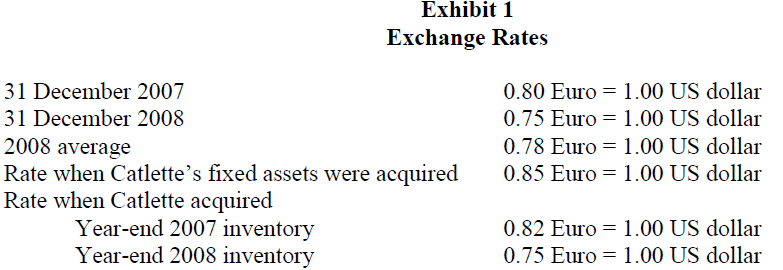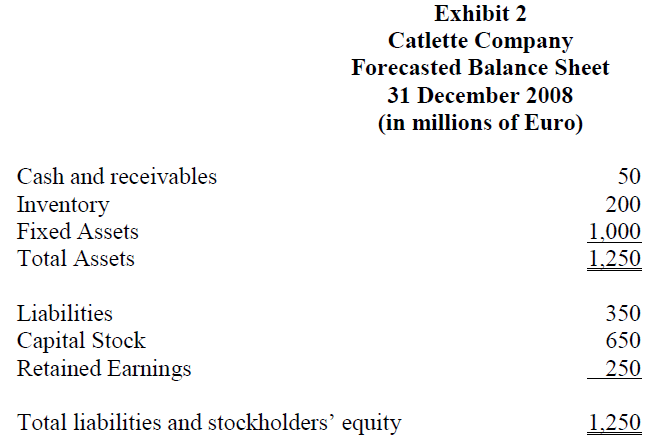Erika Wong Case Scenario
Erika Wong, an analyst with Montreal Investments, is forecasting 2008 results for Garrison Inc.
Garrison has two wholly owned European subsidiaries: Catlette and Heren. Wong has prepared individual forecasts for the parent company (before consolidating the subsidiaries) in U.S. dollars and for the two subsidiaries in their local currency (the Euro). She wants to determine how the translation of subsidiary results will affect the consolidated results of operations, using the following additional information:
? Both Catlette and Heren use the FIFO method for inventory.
? Catlette’s results will be translated into dollars using the all-current method.
? Heren’s results will be remeasured into dollars using the temporal method. Wong’s forecasted exchange rates for the U.S. dollar and Euro are shown in Exhibit 1 along with historical rates. Her forecasted financial data for Catlette Company are presented in Exhibits 2 and 3.
Wong is particularly concerned about whether the choice of translation methods will distort Garrison’s financial ratios relative to the ratios in local currencies. She plans to translate the forecasted financial statements for the subsidiaries into U.S. dollars using the methods which Garrison is expected to use.



19. Considering the translation method chosen, Garrison most likely designated the Euro as the functional currency for:
A. Heren only.
B. Catlette only.
C. both Heren and Catlette.
Answer: B
“Multinational Operations,” Timothy Doupnik 2009 Modular Level II, Volume 2, pp. 137, 155-158
Study Session 6-24-a Distinguish the local currency, functional currency, and the presentation currency.
The functional currency will be the Euro for Catlette since the all-current method is used and the U.S. dollar for Heren (temporal method).
20. When Garrison consolidates Heren’s results, it will ignore exchange rate translation gains and losses on:
A. monetary items if unrealized.
B. nonmonetary items if realized.
C. nonmonetary items if unrealized.
Answer: C
“Multinational Operations,” Timothy Doupnik 2009 Modular Level II, Volume 2, pp. 159-161, 164-167
Study Session 6-24-c
Compare and contrast the current rate method and the temporal method, analyze and evaluate the effects of each on the parent company’s balance sheet and income statement, and distinguish which method is appropriate in various scenarios. Heren’s results will be remeasured using the temporal method. Under the temporal method, translation of non-monetary assets and liabilities are carried out at historical rates, and therefore no unrealized gains or losses result; they will be deferred until realization at which time they will be reported in income. Monetary items are translated at the current rate, and the gain or loss is reported in income whether realized or not.
21. The translation method used by Garrison for Catlette is best justified if:
A. Catlette is a sales outlet for the parent’s products.
B. Catlette is a self-contained independent operating entity.
C. Garrison’s reporting currency is used as the functional currency for Catlette.
Answer: B
“Multinational Operations,” Timothy Doupnik 2009 Modular Level II, Volume 2, pp. 156-158 Study Session 6-24-c
Compare and contrast the current rate method and the temporal method, analyze and evaluate the effects of each on the parent company’s balance sheet and income statement, and distinguish which method is appropriate in various scenarios. Garrison is using the all-current method for Catlette. The all-current method is most appropriate when the subsidiary (Catlette) is a self-contained independent operating entity.
22. When Garrison consolidates Catlette’s results, unrealized exchange rate translation gains or losses on monetary assets will be:
A. unreported.
B. reported in non-operating earnings.
C. reported in equity as a cumulative translation adjustment.
Answer: C
“Multinational Operations,” Timothy Doupnik 2009 Modular Level II, Volume 2, p. 158
Study Session 6-24-c Compare and contrast the current rate method and the temporal method, analyze and evaluate the effects of each on the parent company’s balance sheet and income statement, and distinguish which method is appropriate in various scenarios. All unrealized translation gains or losses are reported as a cumulative translation adjustment in equity when the all-current method is used.
23. When Wong converts her forecasted balance sheet for Catlette into U.S. dollars, total assets at 31 December 2008 (in $ millions) will be closest to:
A. 1,038.
B. 1,510.
C. 1,667.
Answer: C
“Multinational Operations,” Timothy Doupnik 2009 Modular Level II, Volume 2, pp. 164-167 Study Session 6-24-d Calculate the translation effects, evaluate the translation of a subsidiary’s balance sheet and income statement into the parent company’s currency, use the current rate method and the temporal method to analyze how the translation of a subsidiary’s financial statements will affect the subsidiary’s financial ratios, and analyze how using the temporal method versus the current rate method will affect the parent company’s financial ratios.
Under the all-current method, all assets would be translated at the year-end (current) rate of 0.75:
Cash and receivables 50 divided by 0.75 = 66.667
Inventory 200 divided by 0.75 = 266.667
Fixed Assets 1,000 divided by 0.75 = 1,333.333
Total Assets 1,250 divided by 0.75 = 1,666.667
Rounded to 1,667
24. When Wong converts her forecasted income statement data for Catlette into U.S. dollars, gross profit margin for 2008 will be closest to:
A. 27.2%.
B. 30.0%.
C. 32.7%.
Answer: B
“Multinational Operations,” Timothy Doupnik 2009 Modular Level II, Volume 2 pp. 165-167 Study Session 6-24-d Calculate the translation effects, evaluate the translation of a subsidiary’s balance sheet and income statement into the parent company’s currency, use the current rate method and the temporal method to analyze how the translation of a subsidiary’s financial statements will affect the subsidiary’s financial ratios, and analyze how using the temporal method versus the current rate method will affect the parent company’s financial ratios.
Catlette’s income statement will be translated using the average exchange rate:
Sales 1,000 divided by 0.78 =1,282.051
CGS 700 divided by 0.78 = 897.436
Gross profit 384.615
Gross margin: 30.0% (note the same result can be obtained using pre-translation data).
| 
